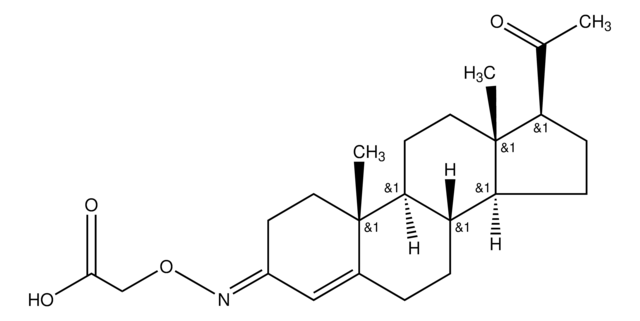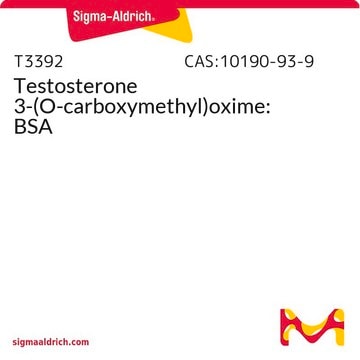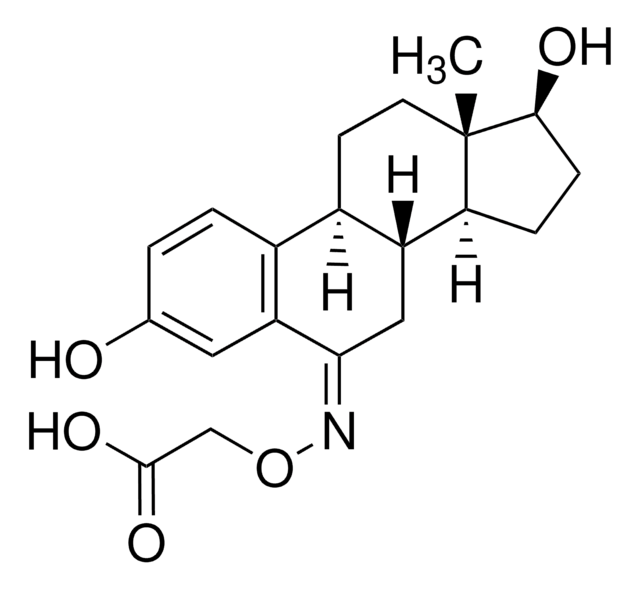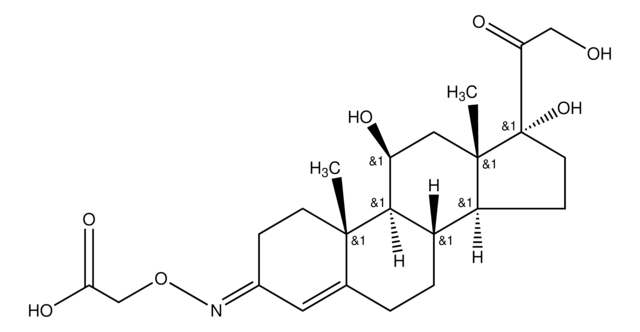T8390
Testosterone 3-(O-carboxymethyl)oxime
Sinonimo/i:
17β-Hydroxy-4-androsten-3-one 3-(O-carboxymethyl)oxime, 4-Androsten-17β-ol-3-one 3-(O-carboxymethyl)oxime
About This Item
Prodotti consigliati
Sterilità
non-sterile
Livello qualitativo
Saggio
≥98.00% (TLC)
Forma fisica
powder
drug control
Home Office Schedule 4.2; regulated under CDSA - not available from Sigma-Aldrich Canada
Solubilità
ethanol: soluble 49-51 mg/mL, clear, colorless to faintly yellow
Condizioni di spedizione
ambient
Temperatura di conservazione
room temp
Stringa SMILE
[H][C@@]12CCC3=CC(\CC[C@]3(C)[C@@]1([H])CC[C@]4(C)[C@@H](O)CC[C@@]24[H])=N\OCC(O)=O
InChI
1S/C21H31NO4/c1-20-9-7-14(22-26-12-19(24)25)11-13(20)3-4-15-16-5-6-18(23)21(16,2)10-8-17(15)20/h11,15-18,23H,3-10,12H2,1-2H3,(H,24,25)/b22-14+/t15-,16-,17-,18-,20-,21-/m0/s1
VDYLVWGBLQNNAW-UVTKPVMCSA-N
Applicazioni
Azioni biochim/fisiol
Nota sulla preparazione
Avvertenze
Warning
Indicazioni di pericolo
Classi di pericolo
Acute Tox. 4 Dermal - Acute Tox. 4 Inhalation - Acute Tox. 4 Oral - Carc. 2
Codice della classe di stoccaggio
11 - Combustible Solids
Classe di pericolosità dell'acqua (WGK)
WGK 3
Punto d’infiammabilità (°F)
Not applicable
Punto d’infiammabilità (°C)
Not applicable
Dispositivi di protezione individuale
Eyeshields, Gloves, type P3 (EN 143) respirator cartridges
Certificati d'analisi (COA)
Cerca il Certificati d'analisi (COA) digitando il numero di lotto/batch corrispondente. I numeri di lotto o di batch sono stampati sull'etichetta dei prodotti dopo la parola ‘Lotto’ o ‘Batch’.
Possiedi già questo prodotto?
I documenti relativi ai prodotti acquistati recentemente sono disponibili nell’Archivio dei documenti.
Il team dei nostri ricercatori vanta grande esperienza in tutte le aree della ricerca quali Life Science, scienza dei materiali, sintesi chimica, cromatografia, discipline analitiche, ecc..
Contatta l'Assistenza Tecnica.









